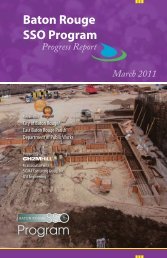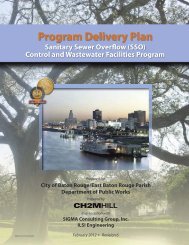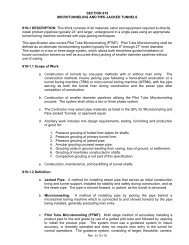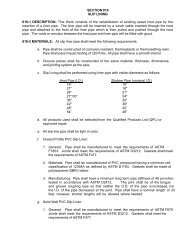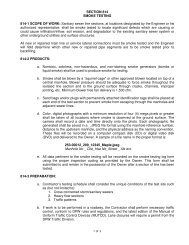Contents
Construction Management Plan - Baton Rouge Department of Public ...
Construction Management Plan - Baton Rouge Department of Public ...
- No tags were found...
Create successful ePaper yourself
Turn your PDF publications into a flip-book with our unique Google optimized e-Paper software.
fever, neck stiffness, stupor, disorientation, coma, tremors, convulsions, muscle weakness,<br />
paralysis, and, rarely, death.<br />
The West Nile Virus incubation period is from 3-15 days.<br />
If you have any questions or to report any suspicious symptoms, contact the HSM or DSC.<br />
2.4.6 Fire Ant Bites<br />
Fire ants are common in the southern U.S. These insects typically build mounds on the land surface<br />
that are usually easy to identify. Avoid disturbing these mounds. A bite from a fire ant can be<br />
painful but rarely is life threatening. However, it is possible that the bite could cause an allergic<br />
reaction. If bitten, check for symptoms of an allergic reaction such as weakness, nausea, vomiting,<br />
dizziness, or shortness of breath. If symptoms appear, seek medical attention<br />
2.4.7 Alligators<br />
Alligator habitat includes large shallow lakes, marshes, ponds, swamps, rivers, creeks, and canals<br />
in fresh water. Smaller alligators eat insects, snails and small fish. Larger alligators eat fish, birds,<br />
turtles, snakes, and mammals. Adults range in size from six to fourteen feet, and up to 600 pounds.<br />
Alligators do attack people. There is an average of over 12,000 alligator complaints a year, with<br />
about four attacks on people a year.<br />
Most attacks happen when they have been fed by humans or when they are defending their nests.<br />
To be safe, there are precautions to take. One, do not feed alligators. Second, never approach an<br />
alligator. Third report nuisance alligators to the Louisiana Department of Wildlife Fisheries,<br />
Alligator Program at (504) 568-5885.<br />
Never kill, harass, molest, or attempt to move the animal. State law prohibits such actions, and the<br />
potential for being bitten or injured by a thrashing alligator is high. Feeding alligators is a violation<br />
of state law and that by feeding alligators; people create problems for others when the alligators<br />
loose their natural fear of people. American alligators are listed by the federal government as<br />
threatened due to the similarity in appearance to the endangered American Crocodile. It is illegal<br />
to feed, tease, harass, molest, capture, or kill alligators. Violations or suspicious activity should be<br />
reported.<br />
2.4.8 Bloodborne Pathogens<br />
(Reference CH2M HILL SOP HSE&Q-202, Bloodborne Pathogens)<br />
Exposure to bloodborne pathogens may occur when rendering first aid or CPR, or when coming<br />
into contact with landfill waste or waste streams containing potentially infectious material.<br />
Exposure controls and personal protective equipment (PPE) are required as specified in CH2M<br />
HILL SOP HSE&Q-202, Bloodborne Pathogens. Hepatitis B vaccination must be offered before the<br />
person participates in a task where exposure is a possibility.<br />
• To eliminate or minimize employee exposure to bloodborne pathogens, observe the following<br />
engineering and work practice controls, recommended vaccinations, and personal protective<br />
equipment.<br />
2.4.8.1 Training and Medical Requirements<br />
• All employees covered by this section must complete CH2M HILL’s 1-hour bloodborne<br />
computer-based training module annually.<br />
A-38 GNV310133632156.DOC/090840008



